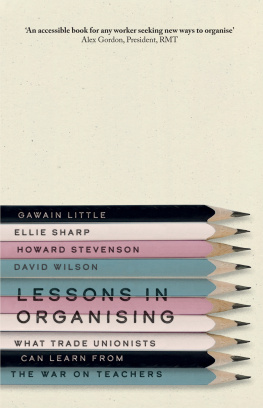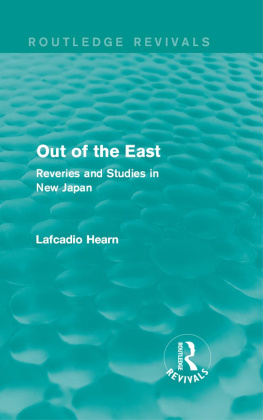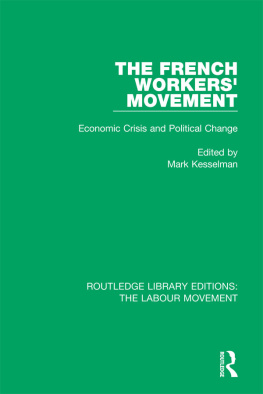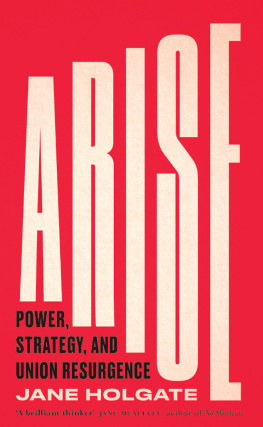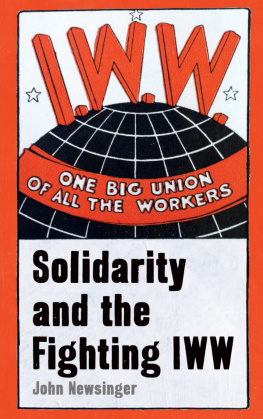Mark Hearn is a lecturer in the Department of Modern History, Politics and International Relations, Macquarie University. He has published widely in the field of Australian history and contributed opinion pieces on Australian politics and history to the press. He was a co-editor of Rethinking Work: Time Space Discourse, published by Cambridge University Press (2006). From 2002 to 2005 he was a sesquicentenary post-doctoral fellow in Work and Organisational Studies at the University of Sydney. In 201415 he was an Australian Prime Ministers Centre fellow at the Museum of Australian Democracy, Old Parliament House, Canberra.
ORGANISING
UNION
TRANSPORT WORKERS FACE
THE CHALLENGE OF CHANGE, 19892013
MARK HEARN
MELBOURNE UNIVERSITY PRESS
An imprint of Melbourne University Publishing Limited
Level 1, 715 Swanston Street, Carlton, Victoria 3053, Australia
www.mup.com.au
First published 2017
Text Mark Hearn, 2017
Images individual contributors, various dates
Design and typography Melbourne University Publishing Limited, 2017
This book is copyright. Apart from any use permitted under the Copyright Act 1968
and subsequent amendments, no part may be reproduced, stored in a
retrieval system or transmitted by any means or process whatsoever without
the prior written permission of the publishers.
Every attempt has been made to locate the copyright holders for material
quoted in this book. Any person or organisation that may have been
overlooked or misattributed may contact the publisher.
Cover design by Philip Campbell Design
Typeset by Cannon Typesetting
Printed in Australia by McPhersons Printing Group
National Library of Australia Cataloguing-in-Publication entry
Hearn, Mark, 1959 author.
Organising union: transport workers face the challenge of change,
19892013/Mark Hearn.
9780522872033 (hardback)
9780522871258 (paperback)
9780522871265 (ebook)
Includes index.
Transport Workers Union of AustraliaHistory.
Transport workersLabor unionsOrganizingAustraliaHistory.
Labor unionsTransport workersAustraliaHistory.
Organizational changeAustraliaHistory.
Industrial relationsAustraliaHistory.
Foreword
Organising Union tells a vitally important story: the experience of TWU members and the turbulent changes affecting their workplaces from 1989, when a new leadership team emerged and reinvigorated the unions organising strategies.
Organising Union describes a recent history, assessing the impact of industry and workplace restructuring. It provides a basis for reflecting on and recasting union strategy to respond to new demands.
The NSW TWU celebrated its 125th anniversary in 2013. The union chose to mark that significant moment by sponsoring the publication of a history that can help shape the future of union organising. It is a future that relies on the active, enthusiastic participation of rank-and-file members, a role that powerfully developed throughout twenty-five years of social and economic transformation.
Organising Union is a testament to the skills and dedication displayed by delegates and members in the face of immense challenges and changes.
Richard Olsen
Secretary
Transport Workers Union, NSW Branch
Building for the future: Richard Olsen (third from right) with Toll members (leftright) Stephen Newton, Mark Warke, Dawid Wojcik, Mark Trevillian and Peter Vandine at the site of the new TWU head office at Minchinbury.
Contents
Acknowledgements
I would like to thank the members and delegates of the Transport Workers Union of New South Wales who consented to be interviewed for the TWU history project. This book would not have been possible without their contributions. I would like to thank Ray Markey and Bradon Ellem for reading the manuscript and offering their helpful comments and suggestions. I would also like to acknowledge the diligent editorial support provided by Melbourne University Publishing. I would like to thank Margaret, Elizabeth, Chris and Tom Hearn for their assistance with the project and their support of me.
Introduction
The Light Horse Interchange
A CHURNING SPIRAL encircles Sydney: the Orbital Network, a large motorway accelerator 110 kilometres long. Particles are pinged through the hinge of the Light Horse Interchange at Eastern Creek and bound away along new orbitsM4, M7following a logistics trail plotted from point to point. Along those sleek black tracks the particlesthousands of surging trucks and vansare fixed on their paths by lines of barcode; everything would literally get lost in our coded world without that little badge of thin strips and the deadline-driven transport worker at the wheel.
The roads that converge on the Light Horse Interchange in western Sydney spool into a frantic workplace of eighteen bridges, eight ramps and two motorways. It is the zone of transport workers, people you rarely notice but always need. Without them, you would not receive the stuff you buy. Transport workers provide what you expect to find on supermarket shelves. Transport workers bring the World Wide Web to life, products delivered to your door from cyberspace. Transport workers feed your cash machines and fuel your car. As the union likes to remind the public, transport workers are Carrying Australia.
In the Light Horse Interchange, symbols abound, signed as you approach from the east in a tight regiment of steel plumes flapping in the traffic vortex, bound in tall red shafts embedded in the median strip: so many thin Anzac headstones. Opened to traffic in 2005, the Light Horse Interchange
How did we get to be in such a hurry? Before the late 1980s, when this story begins, the nations industrial relations system, the transport industry and the union movement all reflected a traditional and apparently stable structure, a steady state world of familiar practices: nine to five work, most dads on the job, most mums at home. Governments owned banks and airlines. Most workers were union members.
Over the two decades from 1989 these structures and practices were transformed. Not a single industry covered by the Transport Workers Union was left unchanged. After 1989, Qantas was privatised and Ansett collapsed, undermining the traditional two-airline policy that once dominated Australian aviation. The cash delivery industry has been challenged by the cashless economy. Remember the old days, when the big retail firms, the soft drink companies, the breweries and the supermarkets operated their own truck fleets? Not any more. Waste disposal workers, once employed by local councils, are now employed by foreign multinationalsoften French: cest la vie. Private bus drivers in the Blue Mountains now answer to head office in Singaporeand that bus driver might be a woman!
That is what this book is about: the journey transport workers in New South Wales have taken from an industrial culture, based on familiar ways of working, to an enterprise culture, driven by new technology and globalisation. Organising Union provides a space in which transport workers can tell the story of that journey in their own words, from their perspective and experience of turbulent and dynamic change.


